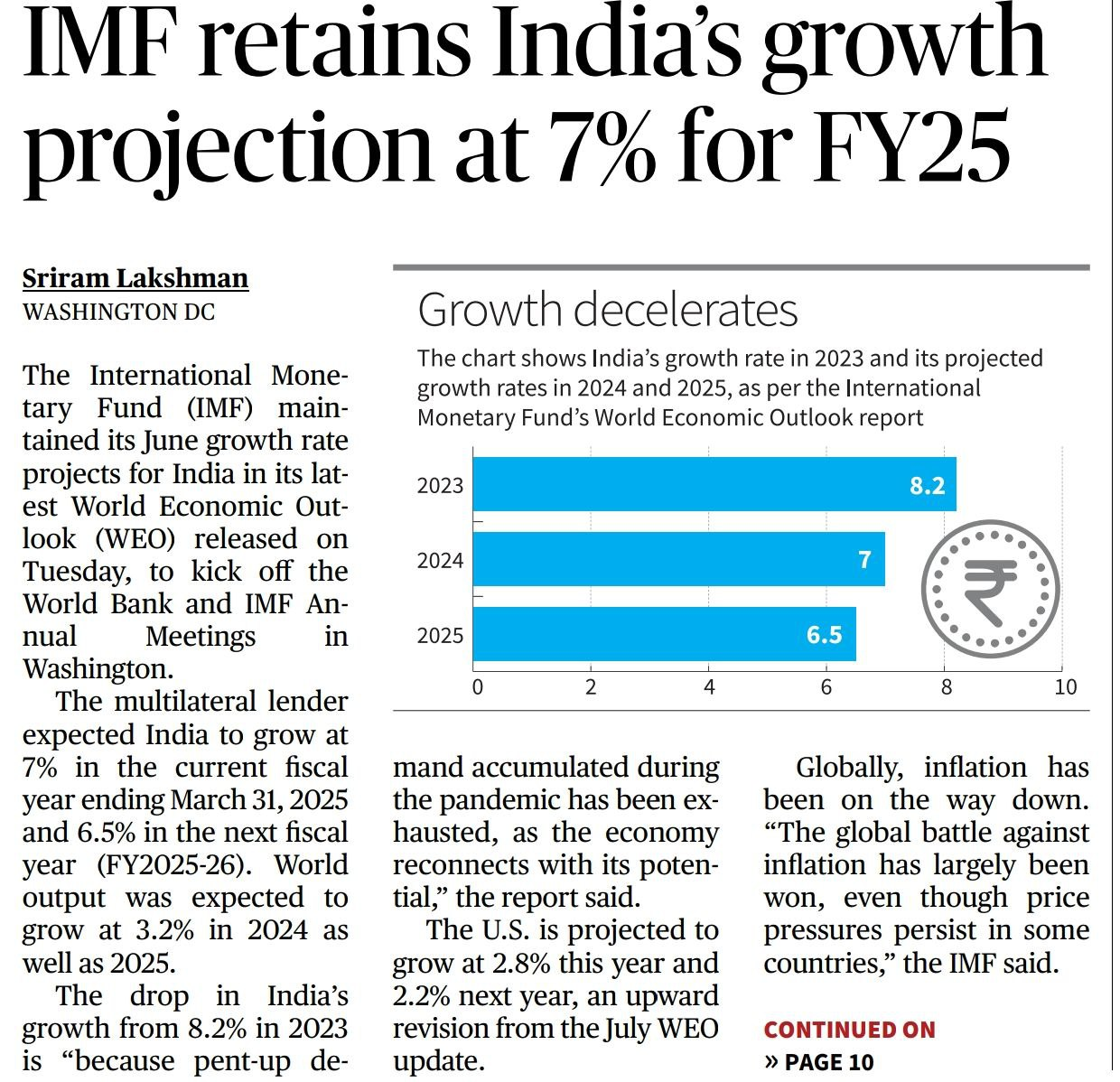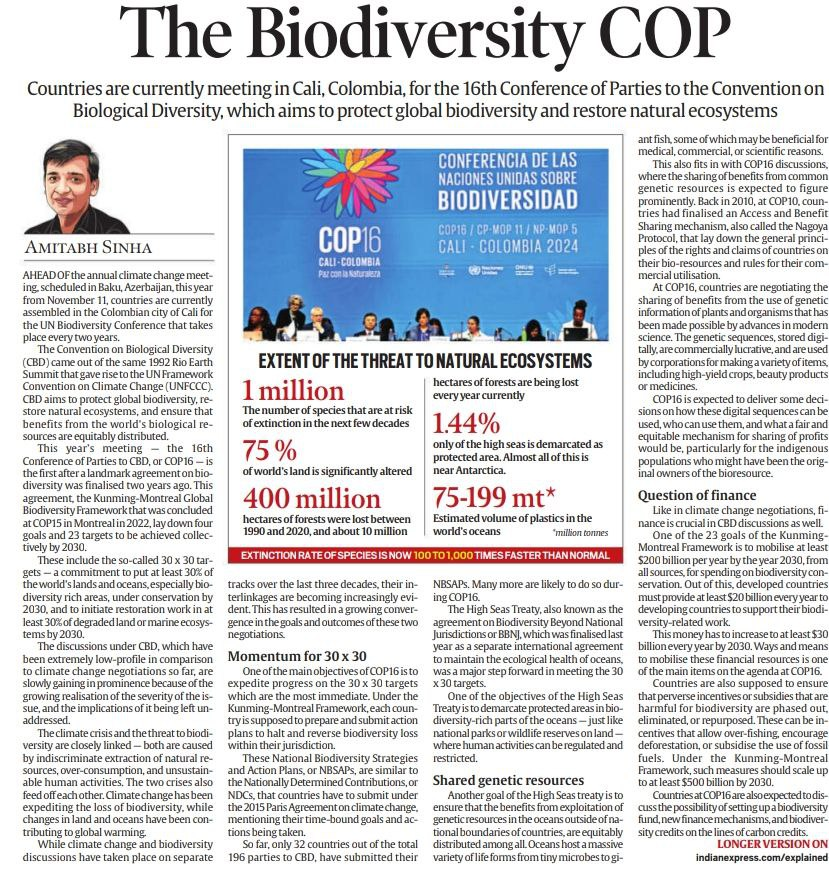1. IMF Retains India’s Growth Projection at 7% for FY25
CONTEXT: International Monetary Fund (IMF) World Economic Outlook (WEO) Report, released during the World Bank and IMF Annual Meetings in Washington DC.
- India’s Growth Forecast:
- 2023: India grew at 2%.
- 2024: Projected growth rate of 7%.
- 2025: Projected to slow further to 5%.
- Reasons for Growth Deceleration:
- The drop from 8.2% in 2023 is attributed to exhaustion of pent-up demand accumulated during the pandemic.
- Economy is reconnecting with its potential post-pandemic, leading to a natural adjustment in growth rates.
- Global Inflation Outlook:
- Inflation has been decreasing globally.
- IMF comments that “the global battle against inflation has largely been won”, although price pressures persist in some regions.
- S. Growth:
- Projected growth for the U.S.:
- 2023: 8%.
- 2024: 2% (an upward revision from the July WEO update).
- Projected growth for the U.S.:
Broader Implications:
- Significance for India:
- Even though growth is slowing, India continues to exhibit strong growth compared to global peers.
- India’s projected growth at 7% in FY25 reflects its resilience and ongoing recovery post-COVID-19.
Policy Focus: This outlook underscores the importance of maintaining structural reforms and fiscal prudence to sustain growth momentum.
2. Mission Mausam and the Cloud Chamber Project
- Objective: Mission Mausam, launched to improve weather forecasting and manage weather events like rainfall, hail, and fog, aims to enhance cloud physics research. This involves both enhancing and suppressing weather phenomena.
- Key Initiative: A first-of-its-kind cloud chamber will be established at the Indian Institute of Tropical Meteorology (IITM), Pune.
Cloud Chamber: Definition and Importance
- What is a Cloud Chamber?
- A cloud chamber is a closed cylindrical or tubular structure where water vapor, aerosols, and other particles are injected.
- Under controlled humidity and temperature conditions, clouds can develop within the chamber.
- This chamber will help scientists study the particles forming cloud droplets or ice particles.
- Mission Mausam’s Cloud Chamber:
- A convective cloud chamber, tailored to study Indian monsoon clouds and associated convection properties, will be created.
- Global Context:
- While many countries possess basic cloud chambers, they are limited in functionality. India’s chamber will have advanced capabilities to study monsoon clouds and other weather phenomena.
Research Significance
- Cloud Physics: Studying cloud behavior under normal and extreme conditions, including intra-particle interactions and droplet formation, can provide deeper insights into weather patterns.
- Weather Modification: Insights gained from the chamber will aid in weather modification strategies such as cloud seeding.
Timeline and Execution
- Research and Development: The cloud chamber will be developed over the next 18-24 months, focusing on advanced instrumentation and probes.
- Research Goals:
- Understanding how monsoon clouds behave.
- Investigating environmental conditions affecting cloud formation.
Application: Weather Modification
- Cloud Seeding in India:
- India has experimented with cloud seeding, particularly under the Cloud Aerosol Interaction and Precipitation Enhancement Experiment (CAIPEEX) in Maharashtra’s Solapur region (2016–2018).
Results indicated rainfall could be enhanced by up to 46%, but cloud seeding is not a comprehensive solution to rainfall problems.
3. The Biodiversity COP (Conference of Parties)
Key Highlights:
- Event: 16th Conference of Parties (COP16) to the Convention on Biological Diversity (CBD).
- Location: Cali, Colombia.
- Objective: Protect global biodiversity, restore ecosystems, and ensure equitable sharing of benefits from biological resources.
- Convention on Biological Diversity (CBD):
- Origin: Emerged from the 1992 Rio Earth Summit.
- Focus: Address global biodiversity loss, ecosystem restoration, and equitable sharing of biological resources.
- Landmark Agreement: The Kunming-Montreal Global Biodiversity Framework (2022), set targets to be achieved by 2030.
- Threat to Natural Ecosystems:
- 1 million species at risk of extinction in the coming decades.
- 75% of the world’s land is significantly altered.
- 400 million hectares of forests lost between 1990 and 2020.
- 44% of the high seas demarcated as protected areas.
- 75-199 million metric tonnes of plastic waste estimated in the world’s oceans.
- Biodiversity Target: 30×30:
- A central goal is to protect 30% of the world’s land and oceans by 2030.
- Focus is on safeguarding biodiversity-rich areas, particularly in developing countries.
- Discussions include enabling mechanisms, financing, and equitable resource sharing.
- High Seas Treaty:
- Known as Biodiversity Beyond National Jurisdiction (BBNJ), this treaty focuses on the protection and sustainable use of marine biodiversity in areas beyond national jurisdictions.
- Aims to create protected marine zones and limit human activities in these regions.
- Momentum for Action:
- Nations have submitted their National Biodiversity Strategies and Action Plans (NBSAPs).
- The 30×30 target is seen as critical to halting biodiversity loss and addressing threats like deforestation and ocean degradation.
- Challenges:
- Financing and Resources: Developing countries need financial and technological assistance to meet biodiversity goals.
Equitable Access: Ensuring all countries, particularly those with limited resources, benefit from genetic and biological resources.
4. Does Madarsa Education Violate Secularism? - Supreme Court to Decide
Key Highlights:
- Supreme Court Case:
- The Supreme Court of India is deliberating on whether Madarsa education violates secularism as enshrined in the Indian Constitution.
- A challenge to the Allahabad High Court ruling, which struck down the Uttar Pradesh Board of Madarsa Education Act, 2004, is under review.
- The case, led by Chief Justice of India D.Y. Chandrachud, could have significant ramifications for religious education in India.
- Background:
- Allahabad High Court Decision (March 2022): Declared the Madarsa Act unconstitutional, arguing that the Act violated secularism by promoting religious education through state mechanisms.
- Secularism Argument: The court cited previous Supreme Court rulings, noting that secularism demands equal treatment of all religions without state endorsement of any particular faith.
- Right to Education (RTE): Article 21A of the Constitution provides for free and compulsory education for children aged 6-14, which the court stated cannot be confined to religious instruction.
- Allahabad High Court Decision (March 2022): Declared the Madarsa Act unconstitutional, arguing that the Act violated secularism by promoting religious education through state mechanisms.
- Madarsa Act, 2004:
- The Act provides a legal framework for madarsa education and integrates religious education into the broader curriculum approved by the National Council of Educational Research and Training (NCERT).
- Qualifications under the Act range from Maulvi (equivalent to Class 10) to Fazil (equivalent to a Master’s degree).
- Key Legal Issues:
- Religious Instruction vs Religious Education: The central question is whether madarsa education constitutes religious instruction (teaching a specific religion) or religious education (teaching about various religions).
- Conflict with Central Law: The High Court ruled that the University Grants Commission (UGC) had jurisdiction over degrees granted, which made madarsa degrees unconstitutional under UGC Act regulations.
- Arguments Before SC:
- First Issue: Whether the Madarsa Act is promoting religious instruction in a way that violates the Constitution’s guarantee of secularism.
- Second Issue: Whether the Allahabad HC’s decision correctly interpreted secularism and its application to religious educational institutions.
- Impact of the Decision:
- If the SC upholds the Allahabad HC ruling, it could lead to the repeal of the Madarsa Act and potentially impact madarsas across India.
The judgment could influence state government policies on religious education and set a precedent for the role of religious institutions within the education system under the Right to Education Act.
5. Section 6A of the Citizenship Act: Key Issues and Supreme Court Ruling
Background
- Section 6A originates from the Assam Accord, a political settlement signed on August 15, 1985, between the Rajiv Gandhi Government and Assam’s student organizations.
- It provided a legal framework for the protection of Assamese identity following concerns about illegal migration from East Pakistan (now Bangladesh).
Provisions of Section 6A
- Cut-off dates for citizenship in Assam:
- March 25, 1971: Migrants who entered Assam before this date from East Pakistan were allowed citizenship.
- Different categories:
- Those who entered before January 1, 1966, were deemed citizens.
- Those who entered between January 1, 1966, and March 25, 1971, were subject to registration and a waiting period before acquiring citizenship.
Why Was Section 6A Challenged?
- Assam Sanmilita Mahasangha and other groups challenged the validity of Section 6A on grounds that it discriminated against indigenous populations by allowing migrants to acquire citizenship.
- The different cut-off dates for Assam (March 25, 1971) as opposed to the rest of India (July 19, 1948) created a legal anomaly.
Supreme Court Ruling
- Judgment:
- The Constitution Bench of the Supreme Court upheld the validity of Section 6A in a 3:2 majority ruling on October 17, 2024.
- The differentiated treatment for Assam was upheld as constitutionally valid, citing historical, geographical, and political considerations unique to the state.
Majority View:
- Justice Sanjay Kishan Kaul and Justice Abhay S. Oka highlighted:
- Assam’s unique position due to historical migration and the impact of Bangladesh Liberation War.
- The framework under Section 6A respects Assam’s distinct identity and protects its culture while providing a humanitarian approach for migrants.
Dissenting View (Justice Pardiwala):
- Justice Pardiwala declared Section 6A unconstitutional:
- Argued that it violated the principles of equality and Article 355 (Union’s duty to protect states from external aggression).
- The differentiation in dates for granting citizenship was termed arbitrary and unjust.
Potential Implications of the Ruling
- Cultural and demographic concerns: The judgment highlights the delicate balance between Assam’s demographic security and humanitarian obligations to migrants.
- Political consequences: The ruling could affect electoral politics in Assam, where citizenship is a sensitive issue.
Relation to CAA (Citizenship Amendment Act, 2019): The ruling may influence the debate around CAA, which seeks to provide citizenship to persecuted minorities from Bangladesh, Afghanistan, and Pakistan.



